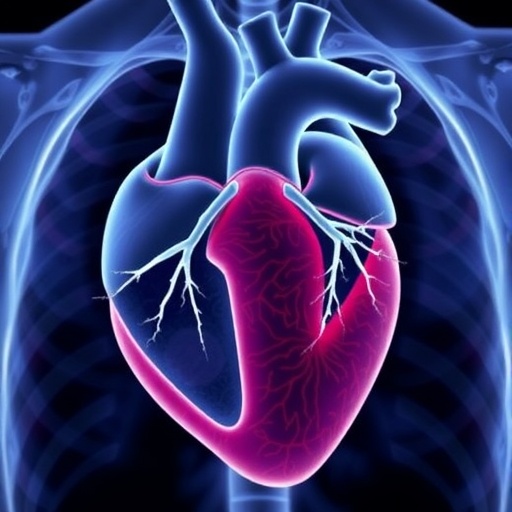Recent advancements in biomedical engineering have ushered in a new era of patient-specific simulations, particularly in the understanding of cardiac valvular pathologies. Among the most intriguing findings in this domain pertains to the bicuspid aortic valve, a congenital heart defect affecting approximately 1-2% of the population. Traditionally, research in this area has focused on broad averages regarding mechanical stress distributions and hemodynamic parameters. However, recent studies indicate that these averages may obscure important individual variability, influencing treatment approaches significantly.
In a groundbreaking study led by Kazik and colleagues, the researchers utilized patient-informed fluid-structure interaction simulations to gain insights into the mechanical dynamics of bicuspid aortic valves in young adults. The study not only highlighted the complexity of blood flow patterns through these abnormal valves, but also underscored the regional differences in mechanical stress that were previously unappreciated in traditional modeling approaches. The implications of such findings could reshape our understanding of the natural history of aortic valve dysfunction and potential interventions.
The research team sought to analyze how differences in valve morphology could lead to varied stress distributions across valve leaflets. Their hypothesis was grounded in the importance of understanding that not all bicuspid aortic valves are created equal. By studying a diverse cohort of patients with specifically documented anatomical and physiological variances, the study aimed to map out these differences in mechanical responses, which are critical for predicting valve-related complications.
Equipped with advanced computational modeling tools, the researchers developed simulations that carefully considered patient-specific geometries and blood flow velocities. The fluid-structure interaction methodology allows for an authentic representation of the interplay between the flowing blood and the valve structure itself. This was a departure from traditional models that often favored simplified assumptions, thus providing a more realistic insight into the stresses experienced by different regions of the valve.
The results found in this paper revealed striking heterogeneity in mechanical stress among individuals with bicuspid aortic valves. In particular, certain regions of the valve faced elevated stress during systolic flow, suggesting a predisposition to structural failure or calcification over time. This localized stress distribution bears implications not just for the understanding of valve function but also for the stratification of risk for future cardiac events, enabling clinicians to tailor surveillance and intervention strategies for their patients.
Moreover, this nuanced understanding of stress dynamics emphasizes the potential need for personalized treatment plans. Conventional guidelines typically apply broad categorical risk stratifications, which may not account for individual anatomic variances. Recognizing that a patient’s specific valve morphology can dramatically influence their clinical trajectory opens the door to custom-tailored monitoring protocols and surgical interventions when necessary.
Another noteworthy aspect of the study was the focus on the young adult demographic, an age group that is often underrepresented in cardiovascular research. By selecting this population, the researchers provided vitally needed data regarding how bicuspid aortic valves evolve during crucial developmental periods. This perspective is essential as many patients may remain asymptomatic for years, only to present later with significant complications due to the accumulated mechanical stress on their valves.
The findings from this research bring forth a paradigm shift that could significantly alter the approach clinicians take in managing patients with bicuspid aortic valves. The use of patient-informed simulations not only serves as an academic endeavor but also translates directly into actionable clinical insights. With the incorporation of such detailed, individualized models into standard practice, there is the potential to improve patient outcomes dramatically and reduce instances of unexpected adverse events.
In closing, this study serves as a testament to the power of interdisciplinary approaches in medicine. By harmonizing computational fluid dynamics with biomedical engineering and clinical cardiology, researchers are positioning themselves to forge deeper connections between scientific inquiry and patient care. With advancements in technology and personalized medicine, the future of understanding and managing congenital heart defects like bicuspid aortic valve looks more promising than ever.
The ripple effects of this research will undoubtedly extend beyond the specific focus on the bicuspid aortic valve. As methodologies continue to evolve, the potential applications for personalized fluid-structure simulations in various cardiovascular conditions may lead to an entirely new frontier in the treatment and management of heart diseases. Continued exploration and validation in broader patient populations will help to elucidate the extent of these findings and solidify their place in standard clinical practice.
As we move forward, the implications of such innovative approaches will not only influence the realm of congenital heart defects but could also inspire further inquiry into a variety of cardiovascular anomalies. Given the elevated risk of adverse outcomes associated with neglecting patient-specific factors, it is imperative that research in this domain continues to thrive, shaping the future landscape of heart health for generations to come.
Ultimately, the integration of patient-informed simulations into clinical practice exemplifies the move towards precision medicine. By providing customized insights tailored to individual patients, healthcare professionals can enhance diagnostic accuracy, optimize treatment strategies, and ultimately improve patient quality of life. In this age of technology and innovation, the importance of such advancements cannot be understated in their role in shaping the future of cardiovascular care.
Subject of Research: Bicuspid Aortic Valve and Mechanical Stress Distribution
Article Title: Patient-Informed Fluid-Structure Interaction Simulations of Bicuspid Aortic Valve in Young Adults Reveal Regionalized Differences in Mechanical Stress
Article References:
Kazik, H.B., Kandail, H.S., Lincoln, J. et al. Patient-Informed Fluid-Structure Interaction Simulations of Bicuspid Aortic Valve in Young Adults Reveal Regionalized Differences in Mechanical Stress.
Ann Biomed Eng (2025). https://doi.org/10.1007/s10439-025-03919-4
Image Credits: AI Generated
DOI: https://doi.org/10.1007/s10439-025-03919-4
Keywords: Bicuspid Aortic Valve, Fluid-Structure Interaction, Mechanical Stress, Patient-Specific Simulations, Cardiovascular Research.
Tags: advancements in biomedical engineeringaortic valve dysfunction understandingbicuspid aortic valve pathologycardiac valvular disease researchcongenital heart defects researchfluid-structure interaction modelinghemodynamic parameters variabilityindividualized treatment approachespatient-specific cardiac simulationsregional mechanical stress differencesvalve morphology impact on stress distributionyoung adults heart valve study





